Mazda 2: Towing
Towing Caravans and Trailers (Europe/Russia/Turkey/Israel/South Africa)
Your Mazda was designed and built primarily to carry passengers and cargo.
If you tow a trailer, follow these instructions because driver and passenger safety depends on proper equipment and safe driving habits. Towing a trailer will affect handling, braking, durability, performance, and economy.
Never overload vehicle or trailer. Consult an Authorised Mazda Dealer if you need further details.
CAUTION
Do not tow a trailer during the fi rst 1,000 km (600 miles) of your new Mazda. If you do, you may damage the engine, transaxle, differential, wheel bearings, and other power train components.
Damage caused by towing a trailer/caravan is not covered by the vehicle's warranty for the following models and countries:
- All models in Turkey
- Saloon models for South Africa
Weight Limits
The total trailer weight, gross combination weight and trailer nose weight must be within the prescribed limits in the Trailer Towing-Load Table.
TOTAL TRAILER WEIGHT:

Sum of weights of the trailer and its load.
GROSS COMBINATION WEIGHT:

Sum of total trailer weight and towing vehicle weight; including trailer hitch, vehicle passengers, and vehicle load.
TRAILER NOSE WEIGHT:

The weight exerted on the trailer tongue. It is varied by changing the weight distribution when loading the trailer.
In a high-altitude operating environment, the engine loses power as elevation increases. In these conditions, a reduction of 10 % per 1,000 m (3,280 ft) in total trailer weight and gross combination weight is recommended.
Maximum trailer towing-load table
Europe/Gradient up to 12%
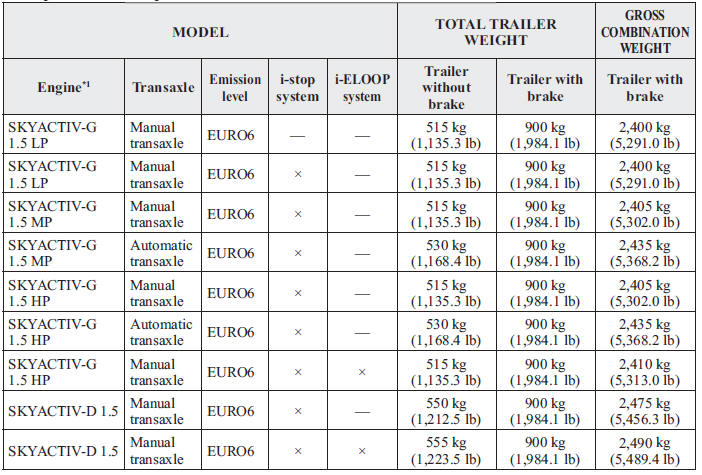
×: Available
—: Not available
TRAILER NOSE WEIGHT: 50 kg (110.2 lb)
*1 The alphabetical letters at the end of the engine types are short for the following:
LP: Low-Power
MP: Medium-Power
HP: High-Power
Germany and Austria/Gradient up to 8%
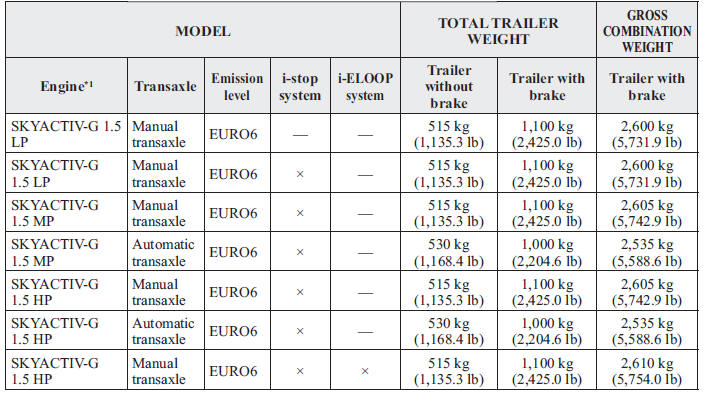
×: Available
—: Not available
TRAILER NOSE WEIGHT: 50 kg (110.2 lb)
*1 The alphabetical letters at the end of the engine types are short for the following: LP: Low-Power
MP: Medium-Power
HP: High-Power
Russia/Gradient up to 12%
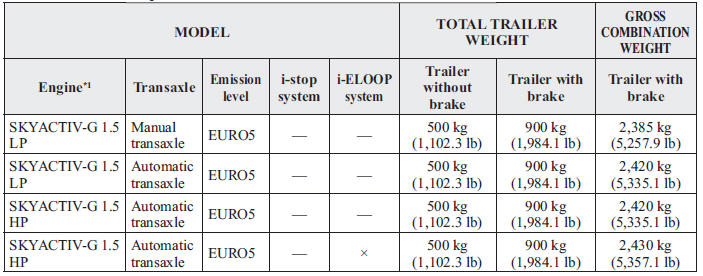
×: Available
—: Not available
TRAILER NOSE WEIGHT: 50 kg (110.2 lb)
*1 The alphabetical letters at the end of the engine types are short for the following:
LP: Low-Power
HP: High-Power
Israel/Gradient up to 12%
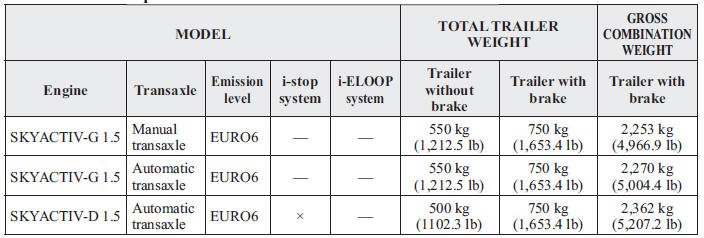
×: Available
—: Not available
TRAILER NOSE WEIGHT: 50 kg (110.2 lb)
South Africa/Gradient up to 12%
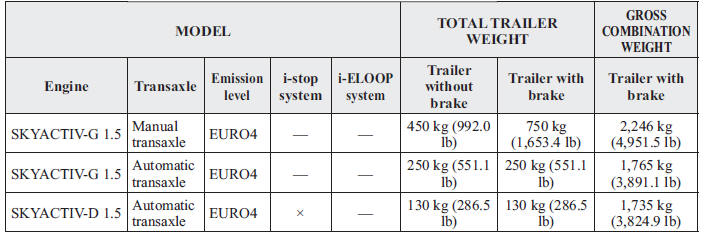
×: Available
—: Not available
TRAILER NOSE WEIGHT: 50 kg (110.2 lb)
WARNING
Always keep tow loads within specifi ed limits as indicated in the Trailer Towing-Load Table: Attempting to tow loads greater than those specifi ed is dangerous as it may cause serious handling and performance problems that could result in personal injury or vehicle damage, or both.
Always keep the trailer nose weight within the specifi ed limits in the Trailer Towing- Load Table: Loading the trailer with more weight in the rear than in the front is dangerous. This could cause loss of vehicle control and an accident.
NOTE
- The total trailer weight and nose weight can be determined by weighing the trailer on platform scales at a highway weighing station or a trucking company.
- Appropriate total trailer weight and nose weight may prevent the danger of trailer sway from crosswinds, rough roads, or other causes.
Trailer Hitch
When towing a trailer, use an appropriate trailer hitch. We recommend using a genuine Mazda trailer hitch. Use the original holes drilled by the vehicle manufacture for securing the trailer hitch. Contact your Authorised Mazda Dealer for more information.
Trailer hitch installation area
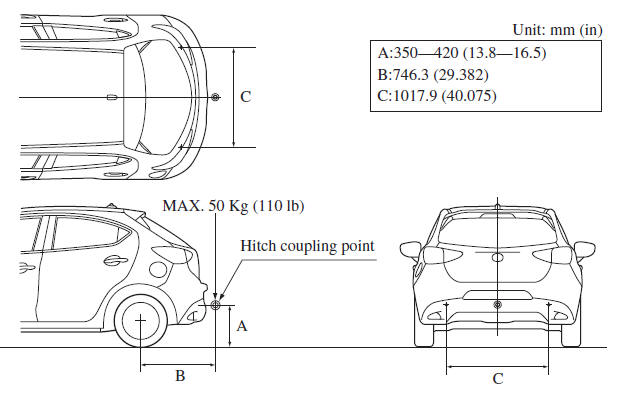
Tyres
When towing a trailer, make sure all tyres are infl ated to the recommended cold-tyre pressure, as indicated on the tyre pressure chart on the driver's door frame. Trailer tyre size, load rating, and infl ation pressures should conform to tyre manufacturer specifi cations.
WARNING
Never use the temporary spare tyre when towing: Using the temporary spare tyre on your vehicle when towing a trailer is dangerous as it could result in tyre failure, loss of control, and injury to vehicle occupants.
Safety Chains
Safety chains must be used as a precautionary measure should the trailer become unintentionally unhitched. They should cross under the trailer tongue and attach to the hitch.
Leave enough slack to allow full turns. Consult literature published by your trailer or hitch manufacturer for more details.
WARNING
Make sure the safety chain is securely attached to both the trailer and the vehicle prior to departure: Towing a trailer without using a safety chain securely attached to both the trailer and the vehicle is dangerous. If damage occurs to the coupling unit or hitch ball, the trailer could wander into another lane and cause a collision.
Trailer Lights
CAUTION
Do not connect a trailer lighting system directly to the lighting system of your Mazda.
This may damage your vehicle's electrical system and lighting systems. To connect the lighting system, consult an Authorised Mazda Dealer.
Trailer Brakes
Check the Maximum trailer towing-load table in Weight Limits (page 3-55 ), and if your trailer weight exceeds the value in the TOTAL TRAILER WEIGHT (Trailer without brake), trailer brakes are required.
If your trailer has brakes, make sure they meet regulations.
WARNING
Do not connect a hydraulic trailer-brake system to your vehicle's brake system: Connecting a hydraulic trailer-brake system directly to the vehicle brake system is dangerous and will result in inadequate braking and possible injury.
Trailer Towing Tips
Before driving
- Verify that your Mazda maintains a near-normal attitude when a loaded or unloaded trailer is connected. Do not drive if it has an abnormal front-up or front-down position. Inspect for incorrect nose weight, worn suspension parts, and trailer overloading. Have the vehicle inspected by an expert repairer, we recommend an Authorised Mazda Repairer.
- Make sure the trailer cargo is secure to prevent it from shifting
- Make sure the mirrors meet all government regulations. Inspect them.
- Before starting out, inspect the operation of all vehicle and trailer lights and all vehicleto- trailer connections. Stop and re-inspect all lights and connections after driving a short distance.
Driving
- Your Mazda will handle differently with a trailer in tow, so practice turning, backing, and stopping in a traffi c-free area.
- Take time to get accustomed to the extra weight and length.
- Do not exceed 100 km/h (62 mph) with a trailer in tow. If the local legal maximum speed with a trailer in tow is less than 100 km/h (62 mph), do not exceed the legal speed.
CAUTION
If the vehicle exceeds 100 km/h (62 mph) with a trailer in tow, the vehicle could be damaged.
- When ascending a hill, shift into a lower gear to reduce the possibility of overloading or overheating the engine, or both.
- When descending a hill, shift into a lower gear and use engine compression as a braking effect. Pay constant attention to speed and use the brakes only as needed. Holding the brake pedal down for a prolonged period may cause the brakes to overheat and lose power.
Parking
Avoid parking on an incline with a trailer. If this must be done, follow these instructions.
Parking on an Incline
- Set the parking brake and the brakes.
- Have someone block the wheels of the vehicle and trailer while you apply the brakes.
- After the wheels are blocked, release the parking brake and the brakes slowly, allowing the blocks to bear the load.
- Set the parking brake fi rmly.
- If the vehicle has an automatic transaxle, put the selector lever in P. If it has a manual transaxle, place the gear shift in 1 or R.
Starting on an Incline
- Start the engine (page 4-5 ).
- Release the parking brake and slowly pull away a short distance from the wheel blocks.
- Stop on the nearest level ground, set the parking brake, and pick up the wheel blocks.

